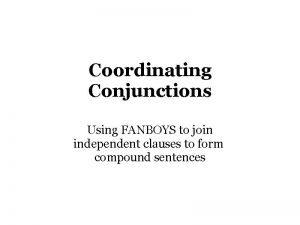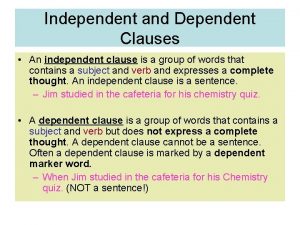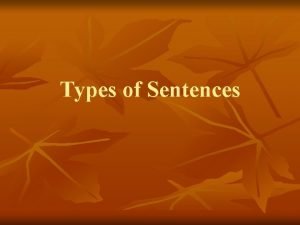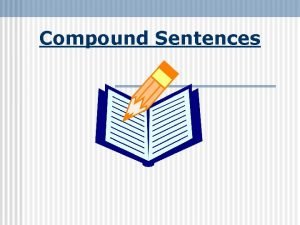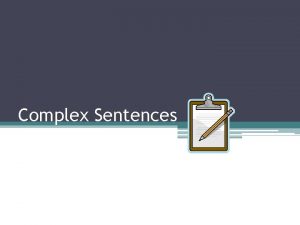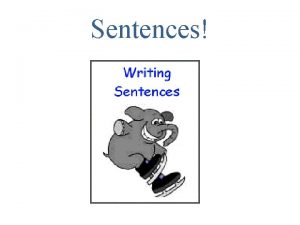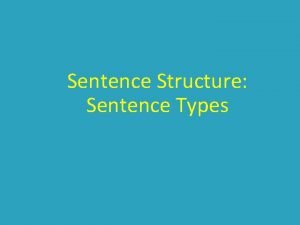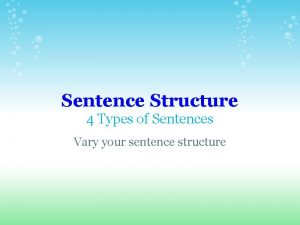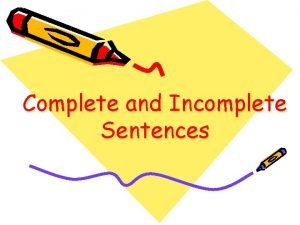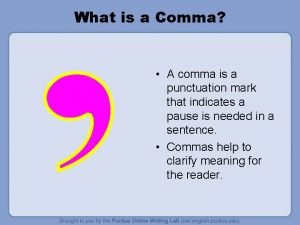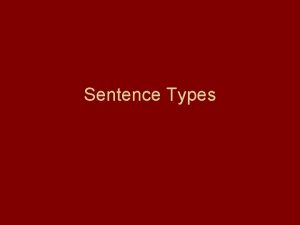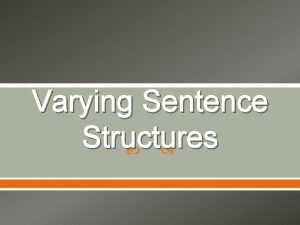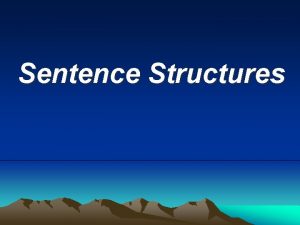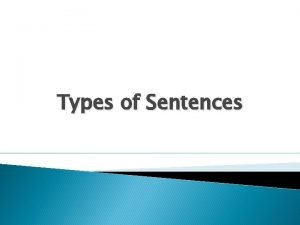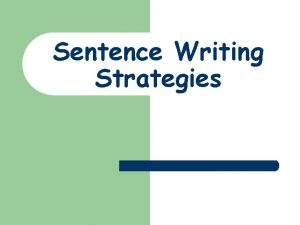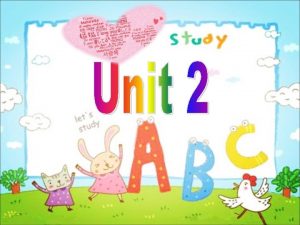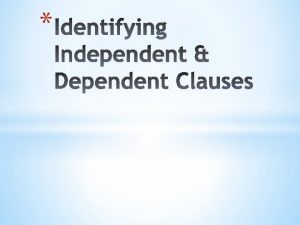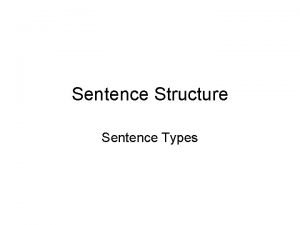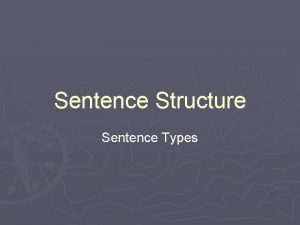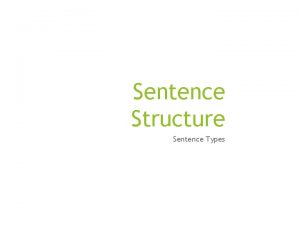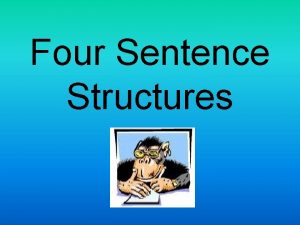Types of Sentence Structures Simple one independent clause
















- Slides: 16

Types of Sentence Structures

• Simple- one independent clause • Compound-two independent clauses joined by a conjunction • Complex- one independent clause and one dependent clause • Compound-complex-Two independent clauses and at least on dependent clause

Determine the sentence structure for each of the sentences below: 1. When I hear classical music, I think of Aunt Amelia. 2. Because she could not hear, she also lost her ability to speak. 3. Sushi and eggrolls are two of my favorite things to eat. 4. I enjoy the pioneer life, but need to escape from the wilderness once in a while. 5. I'll sweep the porch, and Ben will start supper before mom gets home. 6. A variety of fruits and vegetables should be part of everyone’s diet, for they have many important nutrients.

Answers 1. When I hear classical music, I think of Aunt Amelia. Complex 2. Because she could not hear, she also lost her ability to speak. Complex 3. Sushi and eggrolls are two of my favorite things to eat. Simple 4. I enjoy the pioneer life but need to escape from the wilderness once in a while. Complex 5. I'll sweep the porch, and Ben will start supper before mom gets home. Compound 6. A variety of fruits and vegetables should be part of everyone’s diet, for they have many important nutrients that we all need. Compound-Complex

Commas between Coordinate Adjectives

Which sentences use commas appropriately between adjectives? 1. We were prepared for a long, tedious, planning session. 2. Allen owns several blue, wool sweaters. 3. In order to get home, we must travel over several narrow, winding, treacherous roads.

• Only the last sentence is punctuated correctly. • The rulebooks tell us to put commas between coordinate adjectives, but because it is not always easy to tell when adjectives are coordinate, we apply two simple tests to be sure:

• First, we try placing the word and between the two adjectives. • Second, we reverse them. • If, in both instances, the resulting phrase still sounds appropriate, we are most likely dealing with coordinate adjectives and should use a comma between them.

• Let's try those two tests on sentence 1: We could say "a long and tedious planning session" or "a tedious, long planning session. " Thus, we need the comma between the words long and tedious. However, we could not say "a tedious and planning session, " nor could we say "a planning, tedious session. " Thus, we should not use a comma between the words tedious and planning.

• In sentence 2, we do not need a comma between the words blue and wool because the two adjectives are not coordinate. • It would sound illogical to say "blue and wool sweaters" or "wool blue sweaters. "

• The adjectives in sentence three—narrow, winding, and treacherous—are coordinate with one another, so the commas are appropriate. • The word and would sound fine between those words ("the narrow and winding roads" or "the winding and treacherous roads"), • and you could easily rearrange three modifiers in any order.

TEST YOURSELF: Which sentences need commas between coordinate adjectives? 1. In the attic we found old thin paper cutouts we used to play with when we were children. 2. The poster depicted a brown-haired blue-eyed child wearing a red denim shirt. 3. For breakfast we ate two oversized blueberry muffins. 4. We bought two dozen boxes of mouth-watering peanut butter Girl Scout cookies.

ANSWERS 1. In the attic we found old, thin paper cutouts we used to play with when we were children. 2. The poster depicted a brown-haired, blue-eyed child wearing a red denim shirt. 3. For breakfast we ate two oversized blueberry muffins. (no commas) 4. We bought two dozen boxes of mouth-watering peanut butter Girl Scout cookies. (no commas)

Misplaced Modifiers are words or phrases that make the meaning of a word or word group more specific. Example: The boy IN THE RED HAT was crying. The modifier IN THE RED HAT tells us specifically what boy we are talking about. Place modifying words and phrases as close as possible to the words they modify, otherwise they are misplaced modifiers. Example: The boy was crying IN THE RED HAT. See how confusing that sounds?

Identify the misplaced modifier in each of the following sentences. Determine what it is modifying and what it should be modifying. 1. The lady with three legs bought a piano. 2. Flying around the room, I saw three mockingbirds. 3. I bought a puppy for my brother with a cute little tail. 4. I replaced a tile on the floor that was loose.

1. Answers: The lady bought a piano with three legs. (The phrase with three legs modifies the piano, not the lady!) 2. I saw three mockingbirds flying around the room. (The phrase flying around the room modifies the birds, not me!) 3. I bought a puppy with a cute little tail for my brother. (The phrase with a cute little tail modifies the puppy, not my brother!) 4. I replaced a tile that was loose on the floor. (The phrase that was loose modifies the tile, not the floor!)
 Fanboys connectors
Fanboys connectors Phrases vs sentences
Phrases vs sentences Independent clause
Independent clause Dependent and independent clauses
Dependent and independent clauses Independent clause and dependent clause examples
Independent clause and dependent clause examples Area in a sentence
Area in a sentence Logical compound sentence
Logical compound sentence Complex sentence formulas
Complex sentence formulas Hiccup sentence
Hiccup sentence A simple sentence has one subject and one predicate
A simple sentence has one subject and one predicate E ana sentences
E ana sentences 4 types of sentence structure
4 types of sentence structure Function of homologous structure
Function of homologous structure Minor support sentences
Minor support sentences A sentence sentence sentence is complete
A sentence sentence sentence is complete What is an introductory clause
What is an introductory clause What's an independent clause
What's an independent clause
